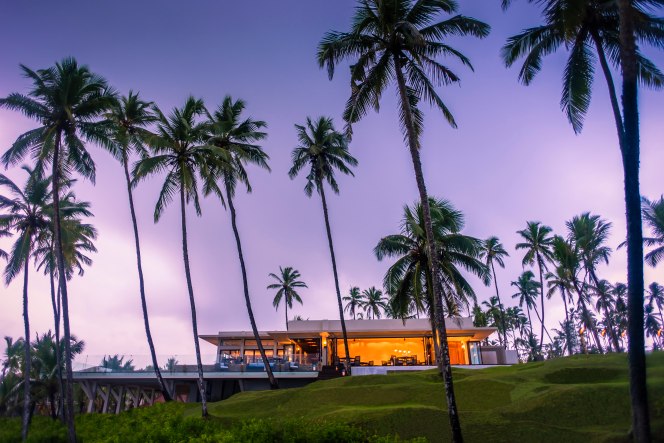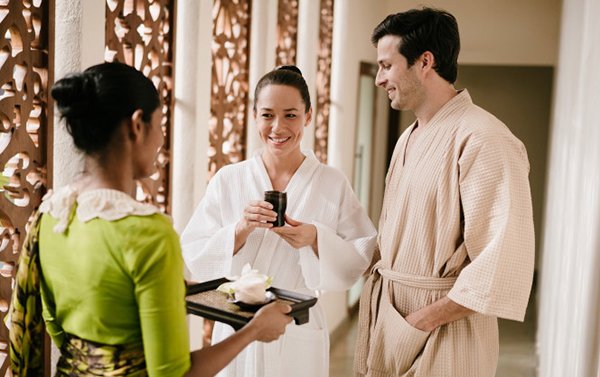With sea-foam waves crashing nearby and coconut palms towering above, I had a revelation. Only I didn’t want to buy the world a Coke. I wanted to get everyone a flight to Sri Lanka’s south coast.
I’d come to the region less for enlightenment and more out of zeal for the new. A dozen years on from 2004’s devastating Christmas tsunami and seven years after the end of a 40-year civil war, Sri Lanka is rebounding, and so its tourism appeal.
This is perhaps nowhere more true than the country’s southern coast, now well connected to the capital of Colombo by fast roads and a regional airport. The last year has seen the arrival of a slew of new hotels, both boutique and big-name, that help holidaymakers immerse themselves in the cultural wonders of the tear-drop-shaped island’s coastal reaches.
To help me discover what a resurgent Sri Lanka had to offer, I turned to the experts at tour company Black Tomato, who pride themselves on helping high-flying travelers get off the beaten path. Not that any path here is all that beaten, except for occasional inroads made by backpackers and surfers, and, on the luxe side, by two small Aman resorts. Which is why Black Tomato co-founder Tom Marchant has a passion for the place.
“If you want to see emerging destinations, it has to be on your radar,” Marchant tells me. “Sri Lankans are waking up to the fact that their country’s got cultured, discerning visitors, and they’re working hard to offer new experiences. They’ve got a pride and reverence for their culture that makes you feel like you’re getting in on something when you’re there.”
Questing after these promises, I flew into Colombo, met my Black Tomato driver-guide, Amith Suranga, and made my way south to Galle. This whitewashed colonial port city on the western end of the southern coast — from which I’d work my way east along the Indian Ocean over the next week — is a favorite of expat Europeans, with a growing arts scene and smart centuries-old courtyard houses converted into hotels.
 Among the newest is Fort Bazaar (from $220), which has layered mid-20th century mod style into the 17th-century digs of a Dutch merchant, adding an east-meets-west restaurant that’s one of the few air-conditioned eateries here.
Among the newest is Fort Bazaar (from $220), which has layered mid-20th century mod style into the 17th-century digs of a Dutch merchant, adding an east-meets-west restaurant that’s one of the few air-conditioned eateries here.
(No small luxury, given the heat and humidity.)
I began by touring Galle’s fortified perimeter walls with Shanjei Malraj Perumal, an advertising exec turned music promoter with a bushy beard and knowledge both historic and present-day about the fortifications.
“There’s a living community here,” he says.
“The fort my mom came to and that I come to isn’t just colonial history. It’s got developing boho-chic culture.”
 That gyp-set vibe was evident at my next stop, the holistic wellness retreat Tri Lanka (from $378), which opened 11 concrete, wood-and-glass, cube-like suites atop a forested hill on the shores of Lake Koggala. At Tri, where the owner’s wife is a yogi, the focus is on asanas, food that modernizes local Ayurvedic dishes and blissful relaxation. I enjoyed this approach while drinking from a green coconut on the boat ride back from a visit to a small cinnamon plantation across the lake. Coconut and cinnamon are king and queen, I learned, in the green, jungled world that is Sri Lanka.
That gyp-set vibe was evident at my next stop, the holistic wellness retreat Tri Lanka (from $378), which opened 11 concrete, wood-and-glass, cube-like suites atop a forested hill on the shores of Lake Koggala. At Tri, where the owner’s wife is a yogi, the focus is on asanas, food that modernizes local Ayurvedic dishes and blissful relaxation. I enjoyed this approach while drinking from a green coconut on the boat ride back from a visit to a small cinnamon plantation across the lake. Coconut and cinnamon are king and queen, I learned, in the green, jungled world that is Sri Lanka.
Coconut made its way into almost every dish I cooked the following day with Manoj and Deevi Hiran, a local couple who welcome guests into their outdoor kitchen.
We prepared 11 recipes — a clay pot-simmered spicy-sour fish called ambul thiyal plus assorted vegetables, salsas, condiments and rice — to create a traditional “rice and curry” meal. Serving ourselves on banana-leaf covered plates, we ate with our right hands, sans utensils, in the traditional way.
Tradition reigned supreme later at Handunugoda Tea Estate, where the its fourth-generation owner — who still has the deed for the plantation from Britain’s King George V — showed me how white-robed harvesters use tiny gold scissors and porcelain bowls to pick buds off the estate’s white tea bushes, all without ever touching them.
Selling for more than $40 an ounce in the estate’s shop and tasting room, it’s one of the most expensive teas in the world, with off-the-charts antioxidants.
Such attention to detail is equally evident at the 152-room, 21-acre oceanfront Anantara Peace Haven Tangalle Resort (from $250) — which is where I had that Draperian moment of ocean-side Zen.
 I spent the next two days here, doing laps in the two 25-meter infinity pools as traditional musicians played in the open-air lobby overhead. I spent time lazing by the beach (the south coast’s rough waters are better for staring at than swimming in). I watched green parrots whip around the palms outside my bungalow at sunset and let go during a deep massage at the spa, later sating myself at the impressively authentic Italian restaurant.
I spent the next two days here, doing laps in the two 25-meter infinity pools as traditional musicians played in the open-air lobby overhead. I spent time lazing by the beach (the south coast’s rough waters are better for staring at than swimming in). I watched green parrots whip around the palms outside my bungalow at sunset and let go during a deep massage at the spa, later sating myself at the impressively authentic Italian restaurant.
Even at this full-service, fully luxe resort — the first of its kind not just on the southern coast but in the entire country — cultural immersion proved key, with Anantara making a point to bring guests on guided visits to local fish and fruit markets. Another excursion was to the nearby Mulkirigala Rock Temple, whose vertiginous steps I climbed to see white-domed Buddhist stupas and vibrantly frescoed, cave-like shrines.
Immersion took on new meaning at my last stop, the safari lodge Chena Huts (from $660), whose 14 domed, thatched-roof, glass-walled bungalows, each with a plunge pool, sit between the Indian Ocean and Yala National Park. That 320,000-acre reserve serves as home to peacocks, spotted deer, a smattering of elephants and, most impressively, elusive sloth bears and sought-after leopards, all of which I managed to see on game drives.
But some of my favorite moments came during al fresco dinners, when water buffalo and wild boar grazed by us on the beach, steps from Chena’s deck, as the sea crested its white-capped waves behind them, their recurring rhythm like a mantra.
And I said, “Om.”
Black Tomato arranges all-inclusive seven-day itineraries to the south coast of Sri Lanka with round-trip flights for $3,789.
(By Andrew Sessa - nypost.com)






